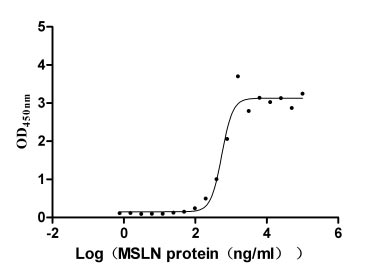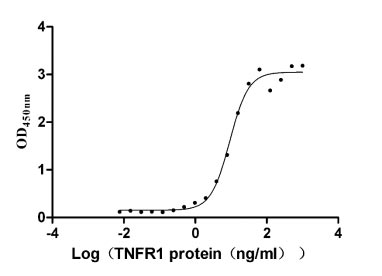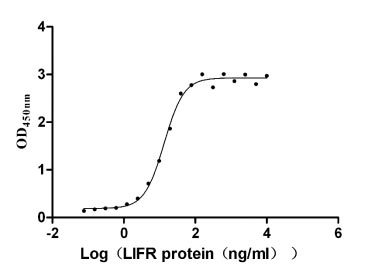Recombinant Human Potassium channel subfamily K member 10 (KCNK10), partial
-
货号:CSB-YP012063HU1
-
规格:
-
来源:Yeast
-
其他:
-
货号:CSB-EP012063HU1
-
规格:
-
来源:E.coli
-
其他:
-
货号:CSB-EP012063HU1-B
-
规格:
-
来源:E.coli
-
共轭:Avi-tag Biotinylated
E. coli biotin ligase (BirA) is highly specific in covalently attaching biotin to the 15 amino acid AviTag peptide. This recombinant protein was biotinylated in vivo by AviTag-BirA technology, which method is BriA catalyzes amide linkage between the biotin and the specific lysine of the AviTag.
-
其他:
-
货号:CSB-BP012063HU1
-
规格:
-
来源:Baculovirus
-
其他:
-
货号:CSB-MP012063HU1
-
规格:
-
来源:Mammalian cell
-
其他:
产品详情
-
纯度:>85% (SDS-PAGE)
-
基因名:KCNK10
-
Uniprot No.:
-
别名:KCNK10; TREK2; Potassium channel subfamily K member 10; Outward rectifying potassium channel protein TREK-2; TREK-2 K(+ channel subunit
-
种属:Homo sapiens (Human)
-
蛋白长度:Partial
-
蛋白标签:Tag type will be determined during the manufacturing process.
The tag type will be determined during production process. If you have specified tag type, please tell us and we will develop the specified tag preferentially. -
产品提供形式:Lyophilized powder
Note: We will preferentially ship the format that we have in stock, however, if you have any special requirement for the format, please remark your requirement when placing the order, we will prepare according to your demand. -
复溶:We recommend that this vial be briefly centrifuged prior to opening to bring the contents to the bottom. Please reconstitute protein in deionized sterile water to a concentration of 0.1-1.0 mg/mL.We recommend to add 5-50% of glycerol (final concentration) and aliquot for long-term storage at -20℃/-80℃. Our default final concentration of glycerol is 50%. Customers could use it as reference.
-
储存条件:Store at -20°C/-80°C upon receipt, aliquoting is necessary for mutiple use. Avoid repeated freeze-thaw cycles.
-
保质期:The shelf life is related to many factors, storage state, buffer ingredients, storage temperature and the stability of the protein itself.
Generally, the shelf life of liquid form is 6 months at -20°C/-80°C. The shelf life of lyophilized form is 12 months at -20°C/-80°C. -
货期:Delivery time may differ from different purchasing way or location, please kindly consult your local distributors for specific delivery time.Note: All of our proteins are default shipped with normal blue ice packs, if you request to ship with dry ice, please communicate with us in advance and extra fees will be charged.
-
注意事项:Repeated freezing and thawing is not recommended. Store working aliquots at 4°C for up to one week.
-
Datasheet :Please contact us to get it.
相关产品
靶点详情
-
功能:Outward rectifying potassium channel. Produces rapidly activating and non-inactivating outward rectifier K(+) currents. Activated by arachidonic acid and other naturally occurring unsaturated free fatty acids.
-
基因功能参考文献:
- The M2-glycine hinge controls the macroscopic currents of TREK1 channels. PMID: 28676394
- This study showed that KCNK10 gene involved in neuronal growth and cerebellum development and associated with neurological and psychological disorders. PMID: 26381449
- The selectivity filter conformations of alternative translation initiation isoforms and wild type human TREK-2 are similar in the S4 site and pHo position. PMID: 26271386
- Results suggest that the cytosolic C-terminal domain and the bottom of transmembrane segment M2 are required for the 2-aminoethoxydiphenyl borate activation on TREK-2 channels PMID: 25982558
- How ion channels sense mechanical force: insights from mechanosensitive K2P channels TRAAK, TREK1, and TREK2. PMID: 26332952
- Modulation of K2P 2.1 and K2P 10.1 K(+) channel sensitivity to carvedilol by alternative mRNA translation initiation PMID: 25168769
- PLD2, but not PLD1, directly binds to the C terminus of TREK1 and TREK2. PMID: 25197053
- crystal structures of TREK-2 channel in 2 conformations and in complex with norfluoxetine, a state-dependent blocker of TREK channels; results provide an explanation for TREK channel mechanosensitivity, regulation by diverse stimuli and possible off-target effects of Prozac PMID: 25766236
- High TREK-2 expression is associated with epithelial ovarian cancer. PMID: 23479219
- Tissue-specific mRNA splicing regulates alternative translation initiation (ATI) of human K(2P)10.1 K+ background channels via recombination of 5 nucleotide motifs. PMID: 21669980
- Expression pattern and functional characteristics of two novel splice variants of the two-pore-domain potassium channel TREK-2. PMID: 11897838
- Predicts the role of TREK-2 in brain ischemia, memory and other tissues.[REVIEW] PMID: 17689202
显示更多
收起更多
-
亚细胞定位:Membrane; Multi-pass membrane protein.
-
蛋白家族:Two pore domain potassium channel (TC 1.A.1.8) family
-
组织特异性:Abundantly expressed in pancreas and kidney and to a lower level in brain, testis, colon, and small intestine. Isoform b is strongly expressed in kidney (primarily in the proximal tubule) and pancreas, whereas isoform c is abundantly expressed in brain.
-
数据库链接:
HGNC: 6273
OMIM: 605873
KEGG: hsa:54207
STRING: 9606.ENSP00000310568
UniGene: Hs.560255
Most popular with customers
-
Recombinant Human Mucin-16 (MUC16), partial (Active)
Express system: Mammalian cell
Species: Homo sapiens (Human)
-
Recombinant Human Tumor necrosis factor receptor superfamily member 1A (TNFRSF1A), partial (Active)
Express system: Mammalian cell
Species: Homo sapiens (Human)
-
Recombinant Human Leukemia inhibitory factor receptor (LIFR), partial (Active)
Express system: Mammalian cell
Species: Homo sapiens (Human)
-
Recombinant Human Nectin-4 (NECTIN4), partial (Active)
Express system: Mammalian cell
Species: Homo sapiens (Human)
-
Recombinant Dog Angiopoietin-2 (ANGPT2) (Active)
Express system: Mammalian cell
Species: Canis lupus familiaris (Dog) (Canis familiaris)
-
Recombinant Human Claudin-9 (CLDN9)-VLPs (Active)
Express system: Mammalian cell
Species: Homo sapiens (Human)
-
Recombinant Human V-set and immunoglobulin domain-containing protein 4 (VSIG4), partial (Active)
Express system: Mammalian cell
Species: Homo sapiens (Human)
-
Recombinant Human Trophoblast glycoprotein (TPBG), partial (Active)
Express system: Mammalian cell
Species: Homo sapiens (Human)




















